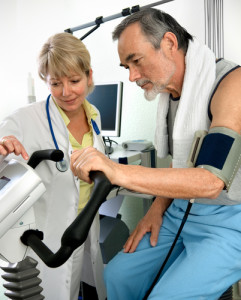Cardiopulmonary Exercise Test for Idiopathic Pulmonary Fibrosis
The cardiopulmonary exercise test otherwise known as a CPET or CPX may be performed to help evaluate the cause of a patient’s shortness of breath or to follow the progress of patients with lung disease. Cardiopulmonary exercise testing aims to measure the rate that a patient’s body takes in oxygen and produces carbon dioxide while monitoring ventilatory parameters, heart rhythm, blood pressure, and oxygen saturation during maximal exercise.
How is a cardiopulmonary exercise test performed?
 The cardiopulmonary exercise test is usually performed in a hospital setting as an outpatient procedure. There is minimal preparation required by the patient for the test. Each center will have their own guidelines for prep and these should be discussed with the patient. Common instructions include eating only a light meal at least two hours prior to the procedure, avoiding carbonated or caffeinated drinks as well as alcohol, and avoiding exercise the day of the test. Well fitting comfortable workout clothes and sneakers should be worn for the test.
The cardiopulmonary exercise test is usually performed in a hospital setting as an outpatient procedure. There is minimal preparation required by the patient for the test. Each center will have their own guidelines for prep and these should be discussed with the patient. Common instructions include eating only a light meal at least two hours prior to the procedure, avoiding carbonated or caffeinated drinks as well as alcohol, and avoiding exercise the day of the test. Well fitting comfortable workout clothes and sneakers should be worn for the test.
The test is performed with the patient exercising on a stationary bicycle (or occasionally walking/running on a treadmill). Sometimes a small catheter is placed in an artery in the wrist. This arterial line is then used to draw blood samples during the test. The patient will also be breathing through a tube much like a pulmonary function test. A blood pressure cuff, pulse oximeter, and EKG leads will also be placed on the patient during the test. A physician will be present during part or all of the test.
The test begins with the patient pedaling without resistance. Every 2 minutes the resistance increases. The time of exercise is patient specific but usually lasts less than 12 minutes. The test will be physically exhausting and the patient will be asked to give it their best effort. Raw data such as blood gasses, blood pressure, and oxygen consumption are gathered during the test. The report will be generated and be sent to a physician, usually a pulmonologist, for interpretation.
What do the results of the CPET reveal?
The patient should set a follow up appointment for a couple of weeks after the CPET to go over the results. Results are not immediately available following the test, as several pieces of information have to be looked at by the physician and melded into a complete report.
The CPET is a valuable test that is useful in answering the the presence of abnormalities and quantifying them. Specific areas addressed include
- exercise capacity
- response to exercise
- ventilatory response to exercise
- gas exchange
CPET is generally not performed in advanced Idiopathic Pulmonary Fibrosis. In early IPF it may be useful in assessing the physiologic impact of mild disease. In patients with more than one cardiopulmonary disease, CPET can help determine the relative contributions to exercise limitation.